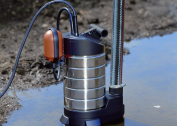Water is one of the main components of an ecosystem. The resource is constantly being replenished, but human activity has a great influence on this process. That is why water supply and sanitation in Russia is strictly regulated and protected by law.
Definition and purpose of water supply and sanitation
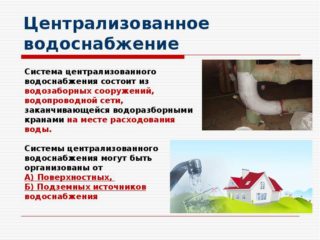 Water supply is a complex of measures due to which people, animals and plants receive the moisture necessary for life. Without the correct and safe laying of the water supply system, the improvement of cities and towns, the development of industry and agriculture is impossible.
Water supply is a complex of measures due to which people, animals and plants receive the moisture necessary for life. Without the correct and safe laying of the water supply system, the improvement of cities and towns, the development of industry and agriculture is impossible.
The water supply system includes engineering structures that perform the following functions:
- water intake from rivers, lakes and springs;
- transportation and storage;
- distribution between houses and enterprises;
- improvement of quality indicators.
No less important is the disposal of water. This concept includes a set of measures for the reception of waste liquids from residential, industrial and economic facilities, purification and return to the natural environment. To exclude the infection of the ecosystem, a well-thought-out sewage system is required to collect sewage, clarify and disinfect it.
Legislative regulation
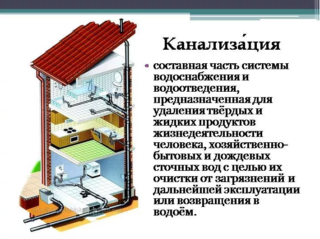 The processes of water consumption and wastewater treatment are regulated by law, primarily the constitution of the Russian Federation. In addition to it, there is a whole list of regulations designed to regulate the consumption of water resources at the federal, regional and local levels. These include the Water, Housing and Urban Planning Code, as well as the Federal Law "On the Sanitary and Epidemiological Well-Being of the Population", "On the Subsoil" and many others. Tariffs for water consumption are set by law, licensing of water supply and sanitation is regulated.
The processes of water consumption and wastewater treatment are regulated by law, primarily the constitution of the Russian Federation. In addition to it, there is a whole list of regulations designed to regulate the consumption of water resources at the federal, regional and local levels. These include the Water, Housing and Urban Planning Code, as well as the Federal Law "On the Sanitary and Epidemiological Well-Being of the Population", "On the Subsoil" and many others. Tariffs for water consumption are set by law, licensing of water supply and sanitation is regulated.
To service the water supply and drainage systems, enterprises must obtain a license, and employees must pass certification. This responsibility is assigned to all specialists responsible for design and construction works, as well as the operation of communication networks.
Licensing is necessary to streamline the work of the housing and utilities sector, increase the operational level of engineering facilities, and minimize the risk of accidents and environmental problems due to incompetence of public utilities and consumers.
Without a license, enterprises are not entitled to enter into agreements with the public on the provision of services related to cold and hot water supply and sanitation.
Interconnection of water supply and sewage systems
During the construction of new cities and towns, renovation and landscaping, the design of water and sewer pipelines goes in close connection. This is a difficult job, because the installation scheme of water consumption and water disposal systems should be planned before the construction of building foundations. And this applies to both internal and external networks.
If water and sewer pipelines are laid in the erected houses, the process is complicated. Exits must be created in the finished walls without violating their load-bearing qualities.
When installing and operating networks for the supply and disposal of liquids, compliance with sanitary and construction standards is mandatory. They include the organization of security zones, the compliance of the supplied water with state standards and standards, the automation of labor-intensive processes and the use of modern technologies.
Types of water supply systems
For the smooth operation of water supply systems, many nuances must be taken into account. To streamline the data, cold and hot water supply systems are divided into categories:
| Criterion | Types of water supply |
| Type of serviced objects | railway, industrial, agricultural, urban, township |
| Water supply method | gravity, pressure and combined |
| Destination | drinking, industrial, firefighter, combined |
| Territorial distribution | local, centralized, group, district |
| The method of sampling from a natural source | superficial, in-depth, mixed nutrition |
| The nature of the use of water | once-through with a drain into the sewer after use, once-through with repeated use of water, reverse with repeated use after cleaning and cooling. |
Each system is assigned one of three degrees of reliability. It depends on the requirements of uninterrupted water supply.
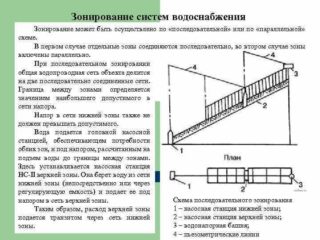 Another classification is based on the method of achieving the necessary pressure. Types of water pipes:
Another classification is based on the method of achieving the necessary pressure. Types of water pipes:
- Acting under pressure in an outdoor water system. The most common and working in cases where the pressure on the input is more than necessary for the consumer.
- Equipped with a water tank. They are used with variable pressure in pipes.
- Equipped with booster pump. They are necessary if the pressure at the inlet is lower than required, or there are too many water consumers.
- Equipped with a booster and water pressure device. Used for uneven water consumption in the building.
In multi-storey buildings, zoning of water pipes is practiced. In the lower zone, water is supplied by pressure from the external system, and on the upper floors - with the help of pumping equipment. The size of each of the zones is detected by the maximum allowable hydrostatic pressure in the lowest section of the highway.
Water supply connection always comes from a centralized network. In private cottages and cottages, water can come from both the central water system and a local source - a well or a well.
Sewage device
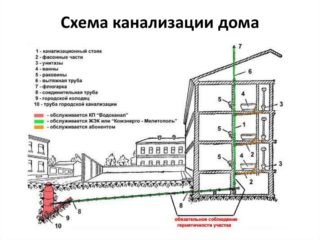 The sewer system according to the mechanism of action is inverse to the water supply: the liquid does not flow to the consumer, but is diverted from it. Sewerage lines are carried out even in small village houses and cottages. But even without a pipeline, the site should be equipped with a local sewage treatment plant, constructed taking into account all sanitary and construction standards.
The sewer system according to the mechanism of action is inverse to the water supply: the liquid does not flow to the consumer, but is diverted from it. Sewerage lines are carried out even in small village houses and cottages. But even without a pipeline, the site should be equipped with a local sewage treatment plant, constructed taking into account all sanitary and construction standards.
The main criteria for proper sewage: the absence of an unpleasant odor, excess humidity, clear functioning without blockages and safety for people and the environment.
In apartment buildings, wastewater goes along the internal highway to a common riser. From there, fluid flows by gravity into a centralized sewer network. The city rainfall directs its waters there. Industrial facilities must install additional treatment facilities.
Private sector buildings can also be connected to the city or village main highway. It is possible to install an individual treatment plant. An important point in planning a drainage scheme is the correct choice of VOCs.
Drainage and sewer systems, working in parallel, provide comfortable accommodation for people in high-rise and low-rise buildings. The operation of the water supply and drainage system is under strict legislative control. This is necessary to maintain human health and the safety of the ecosystem as a whole. Violation of standards, depending on the severity, entails a fine and even criminal liability.

